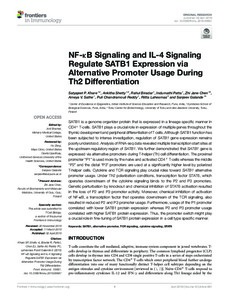NF-kappa B Signaling and IL-4 Signaling Regulate SATB1 Expression via Alternative Promoter Usage During Th2 Differentiation
Satyajeet P. Khare; Ankitha Shetty; Rahul Biradar; Indumathi Patta; Zhi Jane Chen; Ameya V. Sathe; Puli Chandramouli Reddy; Riitta Lahesmaa; Sanjeev Galande
NF-kappa B Signaling and IL-4 Signaling Regulate SATB1 Expression via Alternative Promoter Usage During Th2 Differentiation
Satyajeet P. Khare
Ankitha Shetty
Rahul Biradar
Indumathi Patta
Zhi Jane Chen
Ameya V. Sathe
Puli Chandramouli Reddy
Riitta Lahesmaa
Sanjeev Galande
FRONTIERS MEDIA SA
Julkaisun pysyvä osoite on:
https://urn.fi/URN:NBN:fi-fe2021042827150
https://urn.fi/URN:NBN:fi-fe2021042827150
Tiivistelmä
SATB1 is a genome organizer protein that is expressed in a lineage specific manner in CD4(+) T-cells. SATB1 plays a crucial role in expression of multiple genes throughout the thymic development and peripheral differentiation of T cells. Although SATB1 function has been subjected to intense investigation, regulation of SATB1 gene expression remains poorly understood. Analysis of RNA-seq data revealed multiple transcription start sites at the upstream regulatory region of SATB1. We further demonstrated that SATB1 gene is expressed via alternative promoters during T-helper (Th) cell differentiation. The proximal promoter "P1" is used more by the naive and activated CD4(+) T-cells whereas the middle "P2" and the distal "P3" promoters are used at a significantly higher level by polarized T-helper cells. Cytokine and TCR signaling play crucial roles toward SATB1 alternative promoter usage. Under Th2 polarization conditions, transcription factor STAT6, which operates downstream of the cytokine signaling binds to the P2 and P3 promoters. Genetic perturbation by knockout and chemical inhibition of STAT6 activation resulted in the loss of P2 and P3 promoter activity. Moreover, chemical inhibition of activation of NF-KB, a transcription factor that operates downstream of the TCR signaling, also resulted in reduced P2 and P3 promoter usage. Furthermore, usage of the P1 promoter correlated with lower SATB1 protein expression whereas P2 and P3 promoter usage correlated with higher SATB1 protein expression. Thus, the promoter switch might play a crucial role in fine-tuning of SATB1 protein expression in a cell type specific manner.
Kokoelmat
- Rinnakkaistallenteet [27094]
